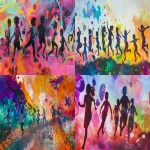Explore the Best AI Image Gallery

5G: A Catalyst for Creative Revolution
The fifth generation of wireless technology, 5G, is rapidly changing the world around us. From self-driving cars to remote surgery, its impact is being felt across diverse sectors. But perhaps one of the most exciting areas where 5G is making waves is in the creative industry. With lightning-fast speeds, ultra-low latency, and massive connectivity, 5G is unlocking a realm of possibilities for artists, designers, musicians, and storytellers, ushering in a new era of creative expression.
Redefining Creative Collaboration
One of the most significant impacts of 5G on the creative industry is its ability to revolutionize collaboration. Imagine teams of artists scattered across the globe, seamlessly working together in real-time on a shared project. With 5G, this becomes a reality. Designers can instantly share and iterate on designs, musicians can collaborate on compositions from different locations, and filmmakers can conduct remote shoots with synchronized editing.
Immersive Experiences and Augmented Reality
5Gs low latency opens the door to immersive experiences that were previously unimaginable. Augmented reality (AR) and virtual reality (VR) applications can now function seamlessly, providing creators with powerful tools to engage audiences in new and innovative ways.
Examples of 5G-Powered Creativity:
- Interactive Installations: Imagine AR sculptures that react to viewers movements or interactive museum exhibits that respond to touch. 5G allows for real-time data processing, enabling artists to create dynamic and responsive installations.
- Virtual Concerts and Performances: 5G enables high-quality streaming of live concerts and performances with minimal lag, allowing fans to experience immersive virtual shows from anywhere in the world.
- 3D Model Collaboration: Architects, designers, and engineers can collaborate on complex 3D models in real time, sharing ideas and making changes instantly. This fosters greater efficiency and innovation in design processes.
Ethical Considerations
While the potential of 5G for creativity is vast, it also raises important ethical considerations:
- Data Privacy: As creative applications increasingly rely on user data, ensuring privacy and responsible data handling becomes paramount. Artists and developers must prioritize user consent and transparency.
- Accessibility: 5G technologys benefits should be accessible to all, regardless of socioeconomic status or geographic location. Bridging the digital divide is crucial for equitable access to creative opportunities.
The Future of Creativity in a 5G World
The convergence of 5G and creativity is still in its early stages, but the possibilities are truly limitless. As 5G infrastructure expands and technology continues to evolve, we can expect to see even more groundbreaking applications emerge. From AI-powered creative tools to personalized interactive experiences, 5G will undoubtedly reshape the future of art, design, and storytelling.
The future belongs to those who embrace innovation and explore new frontiers. With 5G as a catalyst, the creative industry is poised for an unprecedented period of growth and transformation.








](https://images.ai-img.art/thumbnails/150/09ccae5e68e2b6da6b5da87ef69f7eb09e80c99ca39ba886c5c3773cbb3b89ba.webp)













](https://images.ai-img.art/thumbnails/150/44b76c49c47b4c47f13eac7883c63827d3f89aa77fe64ce0cbecb9d3ce434499.webp)








](https://images.ai-img.art/thumbnails/150/47d44e177f427ea6b32f96ea225db96c5158850a0cf01d1bad93e45dd4594430.webp)












](https://images.ai-img.art/thumbnails/150/c48401bc3fad7ff7f2dbd37b894d3f53cb42d5072dfacb8bfdcdeeef28a29b04.webp)




](https://images.ai-img.art/thumbnails/150/c2241c1eabdcb7b9a98be19a7e8d850b6cffe0e0c91c1ccda8dd807e2a96b187.webp)